Recently we spoke to one of our customers whose IT manager had been asked to step up into a CIO role. That’s not unusual. What is interesting is that the organisation decided that it didn’t need to immediately fill the IT Manager role that was left vacant. The reason they gave was the job of keeping the lights on was already being fulfilled by Cloud Direct. We’d become that company’s day-to-day IT.
This story perfectly illustrates the benefits of data centre modernisation. You not only get access to cutting-edge technology like Azure. You also free-up IT’s time for more valuable work, knowing that core IT operations are being taken care of.
Why the changing role of IT is inevitable
Today 86% of CIOs consider digital transformation their first priority (Source: PWC). By 2020, more than 50% of business will focus on creating digitally enhanced products and services to secure their future. Already, nearly half of all technology buying decisions are now controlled by line of business departments that are keen to pursue this digital vision themselves.
This is not an environment in which the old style of IT management can survive. IT that only keeps systems working is not an option anymore. The IT department of the future needs to shift from operating and maintaining technology. Instead, it needs to orchestrate the way technology and applications are used strategically across the business.
Why the change is positive
Businesses that excel are the ones that innovate. Changing the role of your IT through cloud and data centre modernisation will help with that. With time freed-up, IT can focus on innovation in areas like IoT and artificial intelligence. It can also work more closely with all areas of the business to help find answers to the questions that matter to you and your board – such as ‘how can I create this new service and get it to market quickly?’, or ‘how can we improve our marketing and customer experience?’.
IT managers will not become obsolete. But transformational technologies will open up new ways of working.
Working in this way, IT becomes the agent of business-focused digital transformation. Data centre modernisation is not about simply carrying on doing what you did before, only with more up to date technology. It is an opportunity for your business to take advantage of the unprecedented computing power offered by public clouds and take innovation to a new level. The changing role of your IT – itself working at a new level – will be core to that.
Find out more
The new role of IT starts with the cloud and the changes you make to your data centre. Download our whitepaper to find out how data centre modernisation can help you achieve your goals.
We’re delighted to be named one of the Top 50 Fast Growth businesses in the South West 2018.
The list, compiled by Trinity Mirror PLC, highlights the fastest growing companies in the South West and shortlisted Cloud Direct as a finalist for the Technology and Innovation award.
Brett Raynes, CEO of Cloud Direct, said: “It’s fantastic to be recognised as one of the fastest growing businesses in the South West. We are in a rapidly growing market as more companies move to use cloud computing. Our experience and expertise mean we are in a great position to help them do this and therefore to grow ourselves.”
We sat down with Brett to talk about the company’s growth plans and what the future holds for the organisation and its customers.
How is Cloud Direct growing so fast?
“We’re in the world of digital transformation, which is all about helping organisations exploit new technologies to change what they do and how they do it. To disrupt their own market. To launch new services for their customers. To create unique customer experiences. To engage their own employees.
“We provide businesses with these transformational technologies, unburdening them from their old-world IT, so they can realise their potential. We apply these solutions to our own business to drive our development, and we’re growing as a result.”
What does this mean for our customers?
“As we grow and expand the Cloud Direct team, we’re able to nurture and acquire expert talent to ensure our customers are getting the best possible service. Accompanied by the advanced Microsoft support we’re able to offer as Microsoft Partners, our customers receive first class service throughout their cloud journey with us.”
What does that look like in practice?
“For example, we’re collaborating with disability charity Scope, to improve the efficiency of their IT and help them deliver their charitable objectives. They’re currently set to save £100,000 a year after we migrated the majority of their onsite servers to the cloud. We further improve their day-to-day efficiency with our online real-time billing portal, which allows them to simply control their cloud billing and consumption.
“Another customer of ours Côte Brasserie is working with us to harness the power of Microsoft cloud solutions, such as Azure, to uphold the excellent customer experience across their network. Ultimately to maintain a high standard of customer excellence.”
What does the future look like for Cloud Direct?
“To continue our growth, we’re planning to double in size every 12 to 18 months over the next five years, subject to attracting the right talent.
“The demand for transformational technologies is growing enormously. The cloud market globally will be worth £150 billion by 2020. Therefore, the only limit to how fast we can grow is our own ambition.”
Why the South West?
“There’s a huge pool of talent available across the South West, that we’re able to tap into.
“Also, what we do is cloud based so we can service companies from anywhere, and where better to be than the South West!”
The 2018 South West Growth 50 Awards will take place on Friday 9th March at Ashton Gate Stadium. With the finalists published in the Western Daily Press, Bristol Post and Western Morning News.
If you want to find out more about Cloud Direct and what we’re doing, please get in contact with us.
Disaster Recovery as a Service (DRaaS) is better than traditional ways of managing DR. And that is an indisputable fact. It’s cheaper, more flexible and easier to test. But there’s also much more to it than that. For many organisations, DRaaS is also the first step into Azure and exploring the benefits of cloud.
Here are a few reasons why:
Revolutionising Dev/Test
Traditionally Dev/Test has been the poor relation of IT – living on the offcuts of the live production environment. Production infrastructure is refreshed, and when the new hardware comes in, the legacy kit is used for Dev/Test. The result is that Dev/Test of new systems and upgrades takes place in an environment that’s one step behind the real thing.
With DRaaS enabled through Azure Site Recovery (ASR), all that changes. You have the capability to mirror your live production environment at any time and for as long as you need – so why not use it for more accurate and reliable Dev/Test? Many organisations now do. In fact, some of our DRaaS customers have decided that they don’t need a separate Dev/Test environment at all. They just use the cloud.
Delivering high availability
Vendors usually recommend that high availability requires having two sets of servers for everything. This is a very expensive way of doing things. With a DRaaS solution this architecture is not necessary. Most organisations can simply failover to a mirror of the servers you have in the cloud (which you get by default with ASR) whenever needed. The cost is around 10% of the cost of a traditional high availability set up. It’s another step towards cloud, and another demonstration of the cost and efficiency savings you can achieve.
Coping with seasonal demand
What a lot of organisations don’t consider with DRaaS is that they can use it to cope with increases in seasonal demand. For example, a retailer may only need three servers for 11 months of the year but then need another five around Christmas. The same might apply to an events company handling ticketing for a yearly festival, a florist chain gearing up for Valentine’s Day, or any business running a competition or a major promotion. With DRaaS you can send applications and workloads to the cloud temporarily and easily cope with those surges in demand.
Altogether, these benefits create added value that is simply not possible through traditional DR methods. Often, the benefits are so clear that businesses who have experienced DRaaS take the decision to undertake a full migration to the cloud.
Download our paper on the business case for DRaaS to learn how DR can be your springboard to creating new business value from the cloud.
Ever feel like there are too many 365s in the world? First, you had Office 365, giving you simple access to Microsoft Office for a monthly subscription. Now there’s Microsoft 365, which brings together Office 365, Windows 10 Enterprise and Microsoft Enterprise Mobility + Security (EMS) – and you’re being asked to upgrade from one to the other.
But is it worth it?
The simple answer is yes. And I’m not just saying that because I love Microsoft. It’s because our customers are proving that the transition will transform the way you work.
Recently, I’ve seen how moving to Microsoft 365 has benefitted two of our customers operating in highly regulated sectors.
Attracting top talent in the defence sector
The first organisation works in the defence sector. They operate at such a high level of security classification that their systems were completely locked down. Staff had very little opportunity to work flexibly. They also couldn’t use the productivity and collaboration tools they wanted to. This had a huge impact on the firm’s ability to attract top talent. Let’s face it: today’s brightest candidates don’t want to be bound to a desk. And they don’t want to work with antiquated tools if they can work more freely elsewhere.
Microsoft 365 addresses this problem by bringing together the freedom of Office 365 and the security of EMS. Staff can work flexibly on any device in any location. The company is attracting more talent. And the business is protecting itself with security measures that comply with the highest levels demanded by the Ministry of Defence.
Helping councils meet government objectives
And it’s not just new ways of working. Microsoft 365 is also helping organisations meet cost reduction targets set by the government. One of our local authority customers, like many councils, is looking to reduce property costs by making smarter use of its space. Their new property plan includes hot-desking and remote working, however, when it came to implementation they ran into problems with compliance and data protection.
Again, Microsoft 365 provided the solution. The Office 365 component gives council staff the ability to work flexibly from anywhere, while the security built into Microsoft 365 ensures compliance with government security requirements. Meaning full flexible working with protection against malware and ransomware attacks. The solution also allows the selective wipe of company data should a device be lost or stolen. And the end result is that the council’s property rationalisation scheme is back on track.
How could you benefit?
The key message from these examples is that Microsoft 365 will provide a productive and secure working environment that aligns with business transformation goals.
Talk to our experts and learn how your business can benefit from upgrading to Microsoft 365.
Disaster Recovery (DR) is important. We all know that. We only need to remember what’s happened to companies like BA and many others when things have gone wrong in the past. Or to look to the research that says UK SMEs suffer to the tune of £16k an hour when an outage happens. Or to the rise of cybercrime as the fastest growing cause of more and more outages occurring.
So why, given all the evidence, is it that so many companies still never test their DR to check that it’s actually going to work when they need it?
At Cloud Direct, we believe this is a question that businesses should not even think about having to answer. And it’s why, as you’ll find if you read on, we’ve just launched a new solution that makes Disaster Recovery testing much easier to do than it has been in the past.
Too many companies are still taking the risk
Currently, many organisations don’t carry out tests because they think it’s going to be too risky and too much hassle. That’s because traditional DR is usually based on having a second set of servers somewhere (e.g. at another office), and proper tests need to involve shutting down the primary servers to see what happens. Many organisations have deemed this operation to be such a risky and potentially costly task that they never carry out the test at all. As a result, they often discover that when a real disaster happens their recovery is too slow, that their recovered data can’t be read, or that infrastructure changes post-recovery render new devices or applications unworkable.
Thankfully, there is a simple solution…
DR as a Service
Disaster Recovery as a Service (DRaaS) is a relatively new business model for DR that is powered by the capacity, flexibility, security and performance of a new generation of public cloud services. One of its key benefits, amongst many others, is that you don’t have to pay continuously for either the upkeep of your own secondary facility or hardware reserved at your cloud provider. You simply pay for the capacity to failover services whenever the need arises. So when you do need to carry out a test, you simply boot up the required servers in an isolated environment and test them without affecting your primary servers at all. There’s no risk to your business continuity, and systems carry on as normal.
But the real beauty of it is that you can get your DRaaS set up to be tested automatically as often as you like…
Time to take back control
Imagine being able to carry out a test every single day, week or month – in exactly the way you want – and the process being so smooth that you can do the tests without the business even knowing it’s happening?
That’s exactly what you can do with the automated new disaster recovery testing tool we’ve created for Azure Site Recovery (which, as it sounds, is DRaaS built on Microsoft Azure).
There’s no need for weeks of planning. The tool is very simple to use, enabling you to configure what you want to test (whether it’s your web environment, your database etc.) in minutes. You can then set the test to happen automatically (say, for example, once a week), and then once each test is completed – as you can see from the screenshot below – it’s really easy to analyse the results over a given period using a visual dashboard.
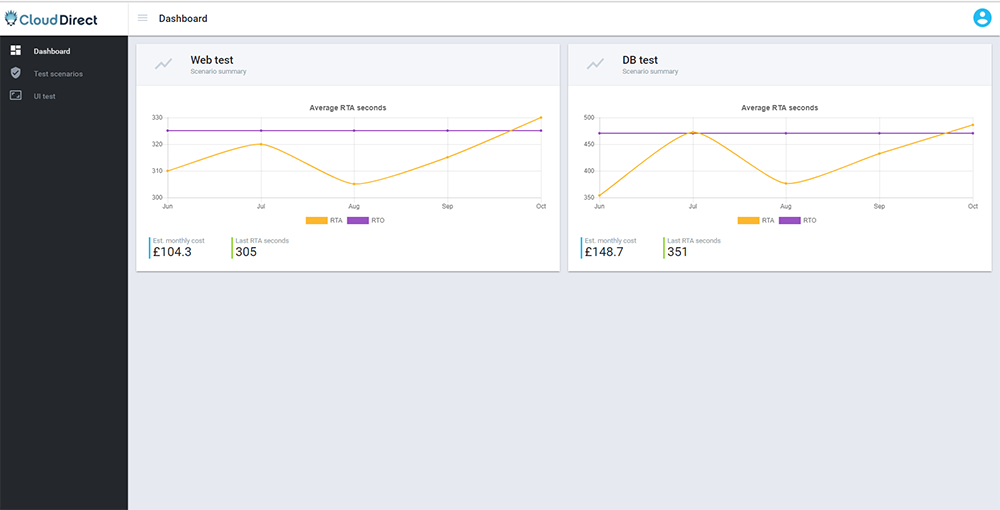
This, in our view, is a really practical and neat step forward that could help companies to start implementing the rigorous testing regimes that they should have been carrying out for years. Especially if they want to avoid the high costs of an outage that we highlighted at the start of this blog.
The best way to make your own mind up, though, is to see how this all works with your own eyes. Just send your request to enquiries@clouddirect.net and we’ll happily give you a demo. Or if you’d like to find out more about the many other benefits of DRaaS, we recommend this whitepaper to help you build your business case.
When people discuss the benefits of cloud, they often talk about the control you can get over cost and the fact you can turn IT resources on and off as you please.
It’s a statement that’s usually been very vague. It’s become one of those things that just trips off the tongue. So you may well have found yourself asking a few questions, such as how am I going to know what to turn off and when? How granular can you really get about this cost control? And how much is this capability really an advancement on the past?
Until fairly recently, this wasn’t always an easy question to answer. But that’s all changing now, and it’s because of the availability of billing tools that make the cost control argument very real.
Comparisons with the energy sector
It strikes me that is going to be like the changes we’ve seen in electricity and gas provision. We’ve always been able to turn those resources on and off to make savings too (a light switch off here, or a TV there). However, until recently we never got to understand what the true benefit of that was. All we got was a lump sum bill every quarter that told us whether we’d spent more or less than we were hoping for.
Now, of course, things are becoming different. With the introduction of smart meters, it’s now possible to access energy information portals and manage your energy use and spending online. You can produce your own reports, analyse how you are using energy, and adapt accordingly.
The benefits are important for businesses in particular. Supermarket chains, for example, are now able to identify periods of the day when their business’s energy demand is high across different areas of the business, such as stores, petrol forecourts and distribution centres. They can see if usage is too high in a particular facility at a particular time of year when it doesn’t need to be. Understanding this really helps them to optimise how they use energy.
A smart meter for your cloud
Perhaps it’s not very well known yet, but the situation is very similar with cloud services. Once, when you used services like Azure, you just got a lump sum bill from Microsoft, much like the energy utilities always provided.
But just like what happened in the energy sector, that’s all changing now. Using billing tools like ours – which you can see below – you can now get a really detailed view of how you consume Azure services. You can look at each individual server, and analyse what different departments are spending on things like storage, virtual machines and data management in a really granular way.
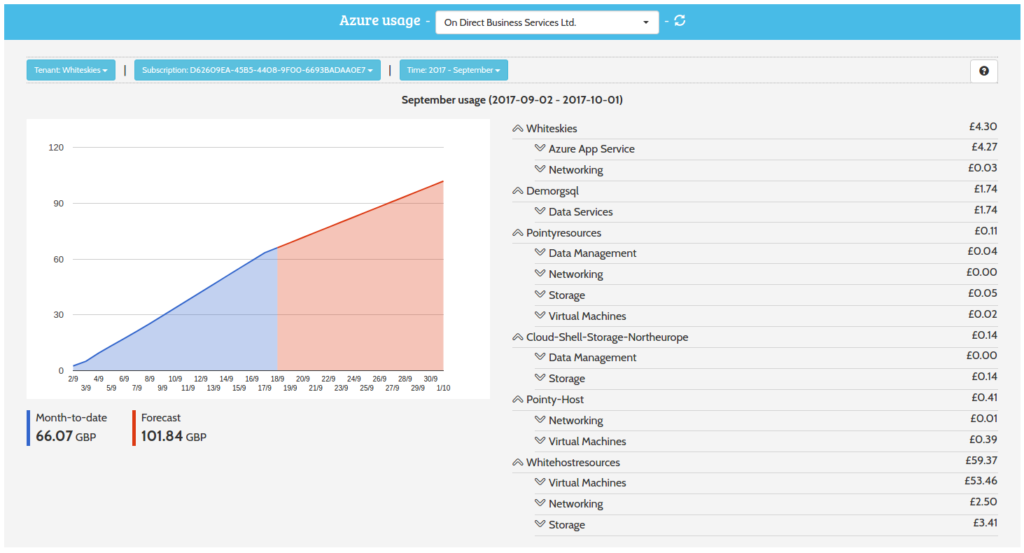
Going back to that smart energy analogy, it’s about getting a new view of consumption that helps you to optimise your environment. You may be able to see that one of your virtual machines is underutilised at night, while the other is overworked and needs more capacity adding. Using our billing tool will help you to divert workloads from one machine to the other without increasing spending. You can even use the billing tool to make detailed spending forecasts.

Another valuable benefit is that you can also use the tool to allocate IT budgets to different departments. By so doing you make them responsible for managing them. This is a really sensible thing to do, because it enables all managers in the organisation to assess cloud costs for their specific purposes and encourages them to get the best possible return for their own investment.
Working smart in this way doesn’t just allow you to optimise IT spending. It will in fact do much more than that, because it helps you to give line of business managers a real understanding of how technology spending can be managed more effectively, dynamically and profitably in ways that will ultimately benefit both them and the business as a whole.
If you are already a Cloud Direct customer and haven’t stated using our billing tools yet, you can access them via our PROVIDE portal, clicking Log-In at the top of the band or by clicking here. If you’re not a customer yet, just get in touch and we’ll be happy to give you a demo.
Recently, we carried out our own data centre modernisation (DCM) programme at Cloud Direct by migrating many of our existing environments to Azure. We frequently say to our clients that data centre modernisation is the first step if you’re serious about any kind of digital transformation or want to take advantage of big new opportunities like Big Data or IoT, so it’s only right that we share our experience of how it’s gone for us here.
First – what is data centre modernisation
So what exactly is data centre modernisation? It’s a rather vague term that sounds like it could mean a lot of things, but in a nutshell, it’s a way of transforming your existing data centres by using the latest technologies in order to (a) improve your data centre’s technical performance and (b) cater to the emerging business needs of the modern connected age.
By ‘latest technologies’, we exclusively mean the new generation of public cloud services provided by global technology giants, such as Microsoft’s Azure. Put simply, data centre modernisation enables you to connect your own infrastructure with these hugely powerful hyper-scale clouds to achieve previously un-thought possibilities.
Why did we feel we needed to do it?
On one level, it was something of a necessity. We’ve acquired a lot of companies over the last few years, which had left us with 15 different sub-scale data centre infrastructures. Naturally we wanted to reduce our footprint to reduce costs and management complexity. But we also wanted to do more than that. We wanted to speed up and cut the complexity of delivering new value added services to our customers.
How did we manage the migration?
The most important thing to say is that planning and analysis in the pre-migration phase are absolutely critical. As you can see from the illustration below, in our case we included thorough analysis of our existing environment, development of a pre-migration Proof of Concept, and building watertight total cost of ownership and financial models. There are other things you need to do (including testing, synchronisation etc.) during the migration phase to ensure a smooth cutover, but we found that it’s this initial business and technical analysis that’s really key to ensuring your project is a success.
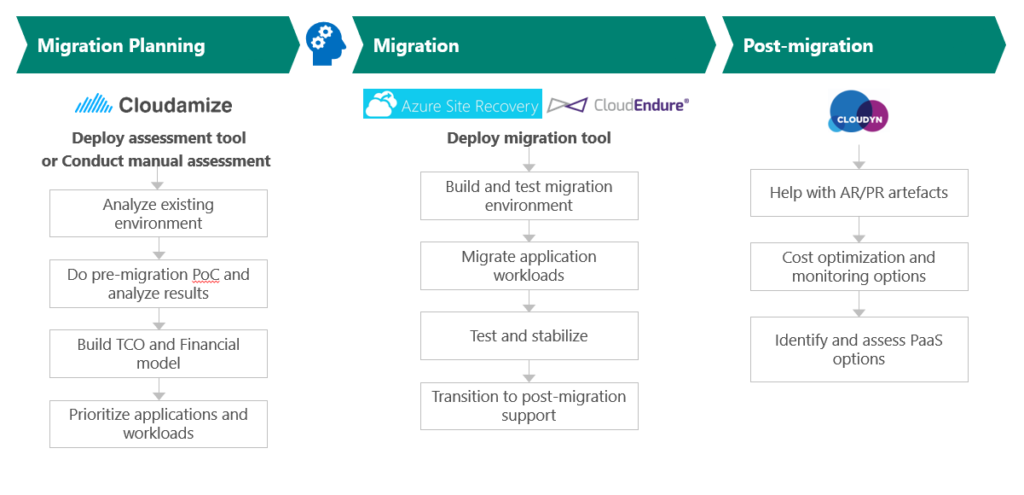
What have we achieved since migration?
Since we completed our data centre modernisation, we’ve achieved significant operational benefits. For a start, we no longer have 15 different data centres to manage! Our IT team isn’t occupied fixing issues with on-premises kit, which also means they are free to work on more strategic projects. Above all though, the big benefit is that we’ve been making use of the incredible performance offered by Azure to rapidly develop and roll out a number of new value added services for our customers. For example ‘My Azure’ our Azure billing portal allows our customers to monitor their spend in real-time, and lets them focus their efforts on further transforming how they deliver their services to ensure innovation is driven by economics. By enabling us to do this, I can honestly say our data centre modernisation project is changing the way we do business for good.
If you’d like to learn more about how data centre modernisation can benefit your business, I’d be happy to take you through what we’ve achieved through our own experience in more detail or carry out a strategy planning session for your business. Talk to one of our experts to find out how you can modernise your data centre.
After attending the open cloud keynote speaker at Microsoft Future Decoded 2017, it is astonishing how Microsoft and its old enemy Linux have become friends.
Let’s be clear how much things have changed – in 2001 Steve Ballmer said that:
“Linux is a cancer that attaches itself in an intellectual property sense to everything it touches”
Now we have this:

This is a penguin that back in 2001 Steve Balmer would have ripped the heart out of and eaten.
While it is astonishing to witness such a shift in views from Microsoft towards its former rival, it makes sense. With the birth of major cloud providers and the types of services they offer, the competition has changed. Microsoft is no longer worried about little things like operating systems, making phones or competing with the likes of Oracle -and why should they be? Microsoft, Amazon and Google are the major cloud players and the more inclusive they are the better services they can offer.
This is why 40% of VMs in Azure are Linux and this number is growing. After all, for things like number crunching and High-Performance-Computing you can’t beat a bit of Linux. Which is probably why Microsoft are rapidly becoming a leading contributor to all things Open Source. For example, by working closely with Ubuntu to ensure that the Linux Operating System is optimised to run in Azure’s Hyper-V environment and the fact they are now the number one GitHub contributor.
If Microsoft had refused to incorporate Linux into Azure, I don’t think it would be one of the market leading public cloud providers that it is today. Well, they would have 40% less VMs for starters.
So, what does this mean for us? Well, it means that more people are working together to give us access to the best technology. Technology that most of us would never have had access to and now we can rent for a few shillings an hour. It is truly an exciting time for technology.
If you would like to talk to an expert about harnessing the power of the cloud, get in touch today.
Talk to an expert
You may have heard this topic shouted from the rooftops in certain circles and spoken in hushed tones in dark server rooms in others. Despite complex and conflicting opinions, a company’s view on data centre modernisation boils down to knowing what it means and how forward-thinking their digital strategy is.
All companies strive to be ‘innovative’. With so many claiming to offer the same, how can you distinguish yourself? Though some may be hesitant to embrace change, a modern data centre will help you become innovative. Here’s how.
It can’t be denied or ignored that the world is becoming more digital. To fight the competition (and prevail) you need to be on the front foot with your technology, to ensure you have the upper hand as the business and technological landscape around us develops.
What does a modern data centre have to offer? The answer is lengthy and will always continue to change. Reason being a modern data centre is always at the bleeding edge of technology, in the sense that previously a virtualised infrastructure was once classed as the modern datacentre (and is still a key factor now) but many technological advancements have happened since then which businesses need to have to flourish and stay ahead of the game.
To achieve this some form of cloud must be used, the reason being there is no way businesses are able to gain access to these technological advancements without the use of it. Unless you have the similar technical expertise in-house and a budget of equivalent size to Microsoft, Amazon or Google you will not even get close to what others are doing in that space. If you can’t beat them, join them.
The 4 benefits of data centre modernisation are:
1. Autonomy of scale
Autonomy means freedom from external control or influence. The ability for a business to scale is key, all businesses want to grow and fulfil their potential, this can be hindered if your IT doesn’t allow this to happen easily. Also when talking about IT scale you need to be able to scale down as well as up, reason being all businesses experience fluctuations based on market trends, seasons etc. meaning your IT does not always need to be at full pelt during low periods as the demand isn’t there. If you can’t scale down, you’re just burning money and reducing your overall profit that year when you could be allocating further resource where the business needs it.
2. Reduced Management
Businesses that excel are the ones that innovate, how can you disrupt like Uber and Airbnb if the people who know what’s possible are always too busy keeping the lights on and maintaining rather than innovating? A modern data centre removes as much maintenance and administration as possible. From reducing the amount of hardware you have onsite, to removing the need to manage everything but the application itself. This will free up staff’s time to focus on the innovation required to beat your competitors.
The best way to sum this up is ‘Pizza as a Service’. It becomes cheaper and less time intensive when you move from on-premise to SaaS. 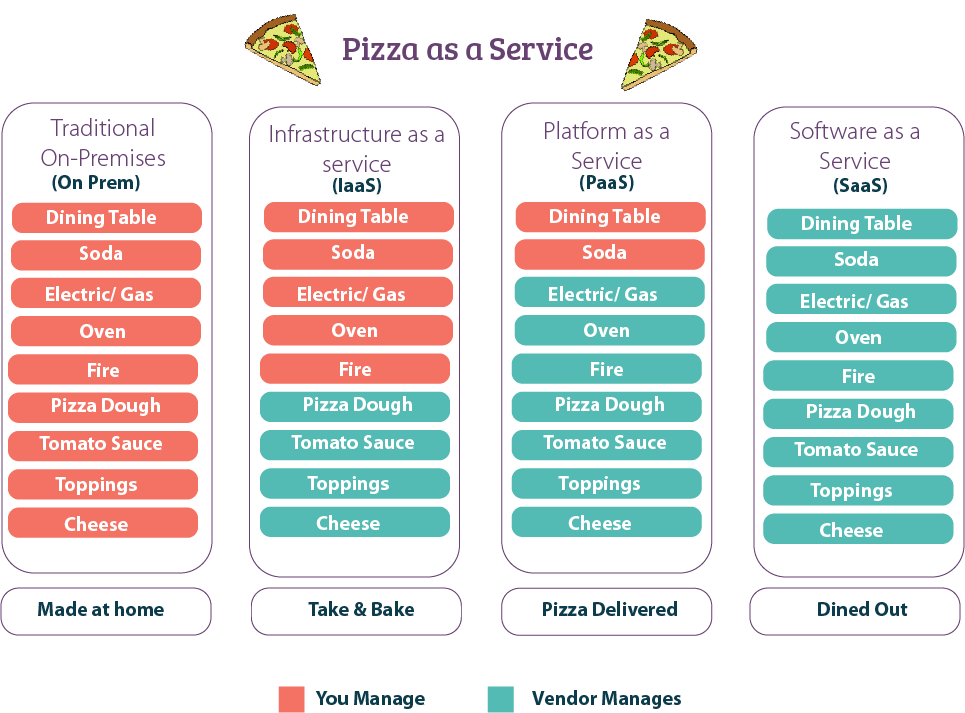
You do manage the knife and fork, but people tend to like feeding themselves.
This analogy for common cloud services known as IaaS, PaaS and SaaS demonstrates how a modern data centre reduces the amount of input required from your business to obtain a service. In the image below you can see how much time, money and effort can be alleviated from IT.

3. Security
Often an objection to utilising cloud services but in most scenarios a key factor on why you should move to the cloud. The UK Governmental Department for Digital, Culture, Media & Sport and National Cyber Security Centre said in a publication that almost half of all UK firms have been hit by a breach or cyber attack in the past year. It’s a sobering thought and that figure is going to rise as methods of attack evolve.
So, how can you ensure your business is safe as the threat continues to grow?
Microsoft continue to invest over 1 billion dollars a year on cyber security making the likes of Azure and Office 365 some of the safest technologies on this planet. This further reduces the amount of time your business needs to spend thinking about cyber security, allowing more time to focus on business evolution.
4. Technological evolution
Technology is advancing at a rapid rate, if you can’t keep up you will be left behind. A modern data centre’s definition is that it is always at the precipice and bleeding edge of technology, Azure puts that directly at your fingertips.
So, what are you waiting for? Being innovative is all about embracing change that could propel your business forward. Still not convinced. See how much you could gain:
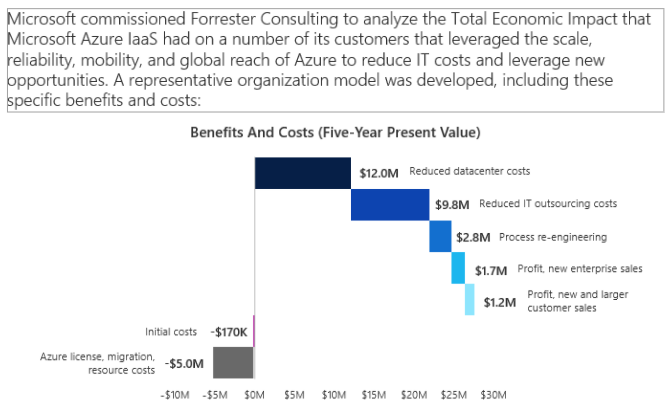
Source: The total economic impact of Microsoft Azure Infrastructure as a Service, June 2017.
To find how data centre modernisation can help your business download our whitepaper, or if you’d like to speak to one of our Azure Experts complete the form below.
Talk to an expert







